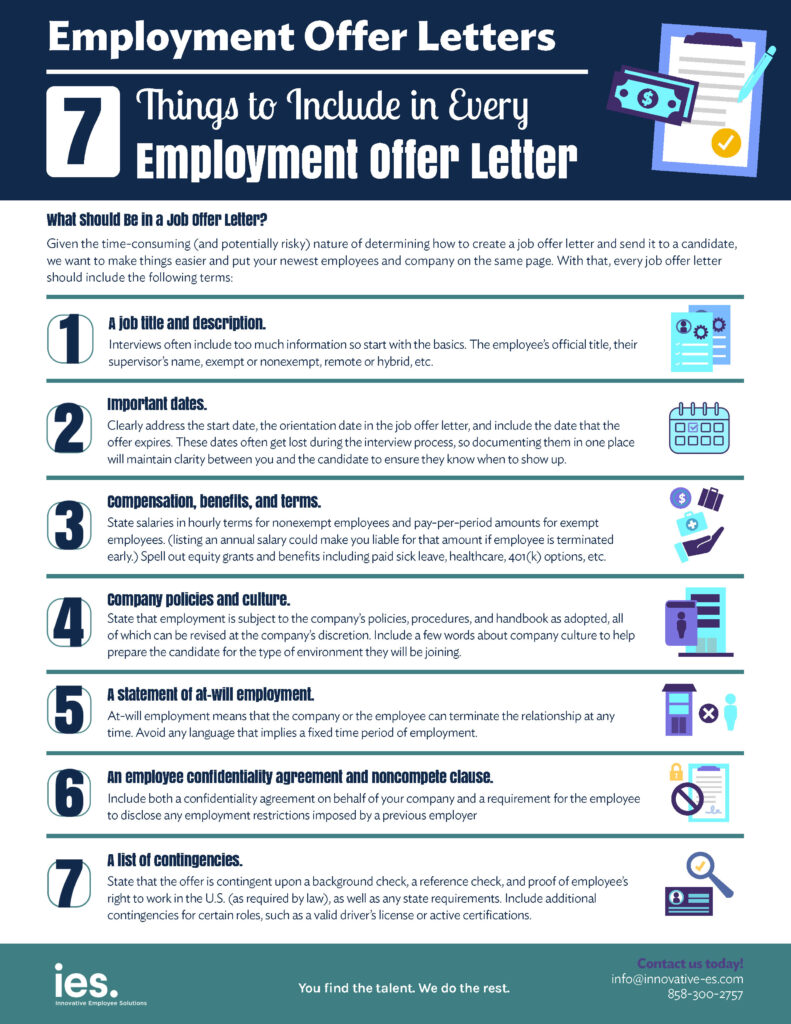How many job offer letters have you sent in your HR career? Fifty? One hundred? Five hundred? Believe it or not, you probably would have sent just one or two offer letters per year a few decades ago. Back then, offer letters were largely written for executive-level or professional roles. But today, with positions becoming increasingly specialized, many HR professionals send them to each and every candidate they aim to bring on board.
Is that excessive? Although you’re not required legally to provide a written job offer letter to a chosen candidate in the U.S., it’s certainly smart. After all, a candidate might have misunderstood a verbal offer or items discussed during the interview process (such as salary, hours, and benefits). Likewise, a supervisor or anyone else in your organization who interviewed the candidate might have given incorrect or misleading information.
The employment offer letter documents a verbal offer, clarifies items discussed during the interview process, and gives candidates an opportunity to ask questions before formally accepting the offer. It also catalogs that the candidate agrees with the terms of the offer and employment, which is why many offer letters require candidates’ signatures.
However, even when a job offer letter clearly spells out the terms, you could run into issues. If it does not clearly state that the offer is contingent upon meeting further requirements — such as a drug test, background check, and verification that a candidate is authorized to work in the U.S. — and a candidate failed to meet them, it can be difficult to withdraw the offer.
In short, offer letters are important no matter the position of the candidate. But it’s critical to include all the right information. So what should be included in a job offer letter?
What Should Be in a Job Offer Letter?
Given the time-consuming (and potentially risky) nature of determining how to create a job offer letter and send it to a candidate, we want to make things easier and put your newest employees and company on the same page. With that, every job offer letter should include the following terms:
1. A job title and description.
Start with the basics. What is the employee’s official title? Who is their supervisor? Interviews often include mentions of many titles and responsibilities, so take this opportunity to clear the air.
Also, be sure to specify whether the position is full- or part-time as well as exempt or nonexempt. For nonexempt hires, give a brief description of your timekeeping process, break requirements, and overtime pay policies.
Don’t forget to share the employee’s work schedule and a short summary of duties. However, state that the offer letter doesn’t constitute a complete job description, and make clear that the employee’s duties are subject to change. Finally, be sure to include the work site information or whether the position is remote or hybrid.
2. Important dates.
Clearly address the start date for the candidate as well as the orientation date in the job offer letter. These dates often get lost during the interview process, so documenting them in one place will maintain clarity between you and the candidate to ensure they know when to show up.
Beyond the orientation schedule, candidates should be informed about performance management and evaluation periods as they prepare to grow at your company. This will provide reassurance that your company fosters an environment of feedback and improvement.
In addition, include the date that the offer expires. The candidate needs to know how long they have to decide whether they will accept the offer, which also helps you plan for when the job offer letter will be returned or if the offer needs to be extended to another candidate.
3. Compensation, benefits, and terms.
After their job title, description, and the relevant dates, what do candidates want to know about next? Compensation and benefits, of course! Beware, though, as this can be a slippery slope.
For example, quoting an “annual” salary might make you liable to pay out the full amount in the case of early termination. Instead, state salaries in hourly terms for nonexempt employees and pay-per-period amounts for exempt employees. Remember to mention that compensation (and benefits) might be modified at the company’s discretion. Be sure to include the pay period, paid time off policy, and holidays in this section as well.
Benefits and equity grants are also a part of compensation, so it’s just as important to state these in writing as it is the employee’s pay rate. Provide a high-level overview of paid time off, health insurance, 401(k) plans, educational assistance, life insurance, short- and long-term disability, flexible spending accounts, and accidental death and dismemberment coverage.
4. Company policies and culture.
Keep this section short and sweet. This isn’t the place for your entire employee manual and company policies. Just include that employment is subject to the company’s policies, procedures, and handbook as adopted, all of which can be revised at the company’s discretion.
Include a few words about company culture here to help prepare the candidate for the type of environment they will be joining. Similarly, express your excitement about bringing the candidate on board and add the contact information of who they can reach out to with questions.
5. A statement of at-will employment.
Avoid creating a contractual agreement in your job offer letter. Do that by including a statement of at-will employment, which means that the company or the employee can terminate the relationship at any time. Also, avoid language that implies a fixed duration of employment (unless, of course, it’s a temporary position), limitations on grounds for termination or resignation, and promises of an indefinite future of employment and promotions. Furthermore, include a general statement that the letter is for informational purposes only and is not a binding contract.
Every word and phrase matter here. Even seemingly harmless statements such as, “Looking forward to a long relationship!” could be interpreted as a contract with the candidate. This misstep can negate the at-will status of an employee and oblige your company to uphold an unintended written or verbal contract.
6. An employee confidentiality agreement and noncompete clause.
Historically, confidentiality agreements and noncompete clauses were mostly restricted to executive employment agreements. But like job offer letters themselves, they’ve become much more common.
Again, be careful writing this part of the job offer letter. Employee confidentiality agreements and noncompete clauses can create legal headaches on both sides for years to come. To avoid burning money in legal battles or losing valuable teammates, offer letters should include a section that prohibits the employee from using confidential information from a previous employer and a statement that candidates must inform you regarding any noncompetition or nonsolicitation agreements they’ve signed with former employers.
The best job offer letters also clearly define that the offer is contingent upon the candidate signing a confidentiality agreement and invention assignment agreement. By having your candidate attest that they aren’t subject to any restrictions, you could save yourself from lengthy litigation down the road.
This is also a big reason why a job offer letter should include a signature line for the candidate to acknowledge they are in agreement and understand all the information in the offer.
7. A list of contingencies.
Be sure to mention that the offer is contingent upon a background check, reference check, and proof of the employee’s right to work in the U.S. (as required by law). Check your state’s specific requirements to be sure you’re covering all your bases. You might also need additional contingencies for certain roles; a valid driver’s license or active certifications are some of the most common.
Additionally, many states have passed a variety of wage theft prevention acts that require the employer to provide a written notice spelling out the terms of employment. These requirements vary by state and timeframes and require much more information than a typical offer letter. If you want to replace an offer letter with the wage theft notice, then it’s beneficial to consult with legal counsel. Many companies are now opting to do both.
Internationally, there are a variety of legal requirements to memorialize offers of employment, some of which require contracts. That’s why it’s important to work with a company that has experience with the local laws before entering into any type of employment agreement in a different location.
Job offer letters might not be legally required, but there are many reasons to use them. By sending them to every candidate, you reduce risk, provide clarity, and align employee-employer expectations. That’s an offer no company can refuse.
Let’s break it down in a quick reference cheat sheet!
Learn more about how Innovative Employee Solutions can help streamline processes for your contingent workforce. You find the talent. We do the rest. Contact us today – let’s get the conversation started.
Co-Written By: Tania Fiero, CHRO and Peter Limone, Chief Financial Officer
Tania Fiero is the chief human resources officer at Innovative Employee Solutions (IES), a leading global employer of record in more than 150 countries that specializes in payrolling and contractor management services for today’s contingent workforce. Founded in 1974 in San Diego, IES has grown into one of the city’s largest women-owned businesses and has been named one of its “Best Places to Work” for 10 years in a row. An expert in joint employment and the Affordable Care Act, Tania helps employers embrace contingent workers in their staffing strategy and culture. She is a Society for Human Resource Management Certified Professional (SHRM-CP) and a Professional in Human Resources (PHR) via the Human Resource Certification Institute. Tania previously served on the board of directors for the National Human Resources Association of San Diego.
Peter Limone is the chief financial officer of Innovative Employee Solutions (IES), a leading global employer of record in more than 150 countries that specializes in payrolling and contractor management services for today’s contingent workforce. Founded in 1974 in San Diego, IES has grown into one of the city’s largest women-owned businesses and has been named one of its “Best Places to Work” for 10 years in a row. Peter joined IES in 2011 as the company’s corporate controller and was promoted to CFO the following year. Prior to his work at IES, Peter worked for 3E Company, where he oversaw integration of the company’s accounting, financial, and tax systems. He has also served as division vice president of finance and information systems at Follett Software Company.







